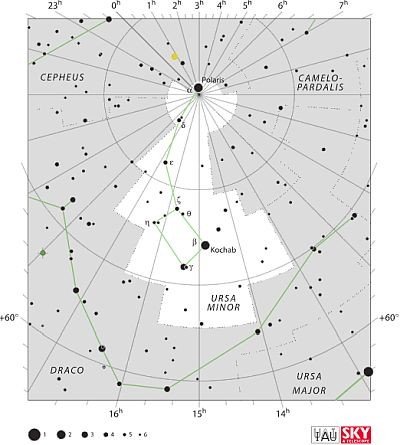Polaris which is commonly known as the North Star or the Pole Star is the brightest star in the constellation of Ursa Minor. Since it is very close to the north celestial pole it is the current northern pole star. Hipparcos parallax method gives the distance of the star of 433 light-years, whereas other methods of calculations give distances around 30% closer.
Polaris star system consists of the main star Polaris Aa, in orbit with Polaris Ab, the pair in orbit with Polaris B. Two more stars Polaris C and Polaris D were once thought to be distant components, but later was found not to be physically associated with the Polaris system.
Polaris Aa with a mass of 5.4 solar mass is an F7 yellow supergiant. Polaris B has a mass of 1.39 solar mass and is an F3 main-sequence star orbiting at a distance of 2400 astronomical units. Polaris Ab (or P) has a mass of 1.26 solar mass and is an F6 main-sequence star with an orbit of radius 18.8 astronomical units.
Polaris system is situated in a direct line with the axis of Earth's rotation above the North Pole. It stays almost stationary in the sky, and all the other stars of the northern sky seem to rotate around it. Hence, it is an excellent fixed point to draw measurements for celestial navigation. In future, the moving of Polaris away from the celestial pole will happen due to the shift in the position of the Earth's axis.
Source: Wikipedia
If you liked my post, then please give an Upvote and Resteem it or follow me, you will be thanked.

Liked your content great.
Downvoting a post can decrease pending rewards and make it less visible. Common reasons:
Submit